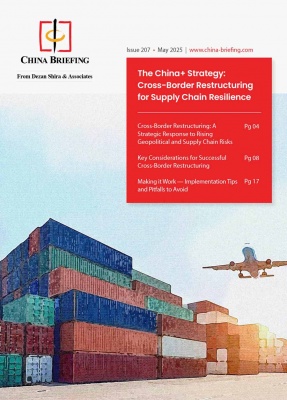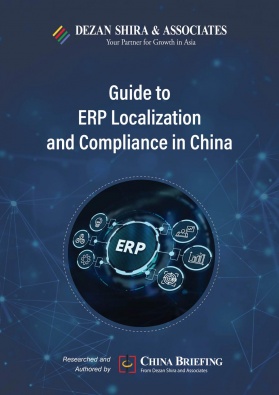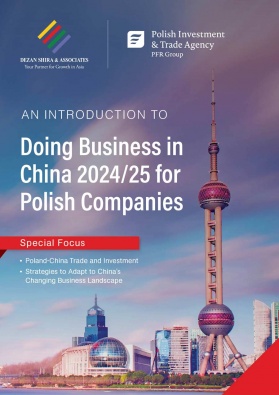China’s New Quality Productive Forces: An Explainer
China’s new quality productive forces represent a new growth model for the country’s economy and society, focused on rapid scientific and technological innovation and the upgrading of traditional industries. As the government emphasizes international cooperation and the role of foreign capital in the development of disruptive technologies and seminal scientific breakthroughs, a myriad of new opportunities are emerging for foreign investors and companies.
The term new quality productive forces (NQPFs) has recently emerged as a key concept in China’s economic strategy, appearing in official statements, policy documents, and high-level government meetings since late 2023.
It has become a core priority for China’s economic development, which is shifting its focus to cultivating cutting-edge technologies and scientific breakthroughs to drive new growth and enhance the country’s global competitiveness.
This growing focus on NQPFs signals a strategic shift towards innovation-led growth and potentially marks a new era in China’s economic trajectory, making it crucial to understanding China’s evolving market landscape.
Understanding new quality productive forces
The term NQPFs denotes an innovation-led economic growth model wherein emerging and disruptive technologies give rise to a new array of industries, economic models, and social structures. NQPFs also serve the purpose of transforming traditional industries and structures, modernizing them through processes such as digitization, connectivity, and smart upgrades.
The term has its roots in Marxism, which categorizes human labor and key resources such as tools and machinery as the “productive forces” driving the economy. NQPFs today refer in particular to the technologies of digitalization, networking, and intelligence, which have spawned a new era of scientific and technological innovation, new industries and economic models, and social development.
As explained by Yu Fengxia, a senior economist at the National Information Center, “Under the joint effects of new-generation technologies and data elements, new business forms and models continue to emerge, and the transformation of traditional industries continues to advance. The resulting impact is reflected not only in the fields of natural sciences, economic development, and productivity but also has a revolutionary impact on the machinations of human society, production organization methods, social organization operations, and social system.”
Despite its roots in Marxist theory, the focus on NQPFs does not indicate a shift to a more state-led economic model, as China’s government policy has consistently stressed the role of market forces and private investment in innovation and technological development.
The term NQPFs first began appearing in official statements and documents in late 2023 and has since become one of the most important concepts guiding economic policy in 2024. During a trip to northeastern Heilongjiang province in September 2023, President Xi Jinping told the Provincial Party Committee and the Provincial Government that China needs to “lead the development of strategic emerging industries and future industries, and accelerate the formation of new quality productive forces.”
The term was used again during the 2023 Central Economic Work Conference (CEWC), a high-level annual event that sets the economic blueprint for the coming year. The CEWC report highlighted promoting “industrial innovation with scientific and technological innovation”, “disruptive and cutting-edge technologies to give birth to new industries”, and “developing NQPF” as core priorities for 2024.
The 2024 Government Work Report (GWR) released during the Two Sessions in March 2024 also placed it as one of the top government work tasks for the year. The GWR called for “accelerating the development of NQPFs”. It goes on to emphasize the need to “fully leverage the leading role of innovation, promote industrial innovation with scientific and technological innovation, accelerate the promotion of new industrialization, improve total factor productivity, continuously create new momentum and new advantages for development, and promote a new leap in social productivity.”
The term was most recently raised in the policy document passed during the 2024 Third Plenum released in July, which called for “improving the system and mechanism for developing NQPFs in accordance with local conditions”. Specifically, it called for “promoting revolutionary technological breakthroughs, innovative allocation of production factors, and deep transformation and upgrading of industries”.
The new quality productive forces economic growth model
The focus on NQPFs marks an important change from an investment-led growth model to an innovation-led growth model. In the decades since the implementation of the Reform and Opening Up policy initiated in the 1980s, China has undergone rapid economic changed spurred in large part by huge levels of investment in areas such as infrastructure and export-led manufacturing.
Under the NQPFs model, economic advancement will be achieved primarily through scientific and technological innovation, which will lead to the development of cutting-edge and disruptive technologies with the potential to transform China’s traditional industries and create new springs of economic activity.
This shift is partly a response to the economic realities currently facing China and the world. Global economic growth has slowed considerably in recent decades. The IMF forecasts the world’s GDP growth to reach 2.8 percent by 2030, below the historical average of 3.8 percent, “absent major technological advances or structural reforms”. China’s GDP growth is following a similar trajectory, slowing from an average of 10.4 percent between 2000 and 2010 to an average of 7 percent between 2011 and 2021.
This slowdown has coincided with a gradual change in China’s economic structure, with a relative increase in services and a decrease in industry and manufacturing as a proportion of GDP. Moreover, as labor and resource costs have risen, producers of lower-value goods in particular have begun moving their production to lower-cost regions, such as South and Southeast Asia.
In addition to slowing economic growth, a growing backlash against globalization, in particular in Western countries, is leading to a rise in trade and investment protectionism. This is resulting in a restructuring of global supply chains to focus more on diversification and regionalism. At the same time, this shift is driving a desire for self-sufficiency, which, both in Western countries and China, relies in large part on advancements in science and technology and the development of new and innovative technology.
All of these factors inform China’s drive to become a leader in scientific and technological innovation. Digitalization and smart upgrading can help to move traditional industry and manufacturing sectors up the value chain, keeping them competitive and future-proof.
Meanwhile, the development of domestic high-end technologies, such as artificial intelligence, biotechnology, semiconductors, new energy, and new materials, to name a few, will guarantee China’s leading role within these industries in the future and the economic development that may come with it.
NQPFs are closely related to the concepts of “new industries” and “new-type industrialization”. The new-type industrialization initiative, as with NQPFs, seeks to achieve industrial advancement and technological self-sufficiency while bolstering China’s global competitiveness, positioning it as a leading player in frontier sectors and high-tech industrial value chains.
Meanwhile, “new industries” refers to emerging technologies that are still in their “embryonic stage” or at an early stage of industrialization, but have the potential to significantly disrupt and transform current industries.
A set of implementation opinions released by the Ministry of Industry and Information Technology (MIIT) and other government bodies in January 2024 sets a series of goals for the development of new industries, which include achieving breakthroughs in 100 cutting-edge key technologies, forming 100 “iconic products”, creating 100 leading enterprises, and cultivating 100 professional service institutions by 2025.
Examples of “iconic products” include humanoid robots, quantum computers, new-type displays, 6G networks, brain-computer interfaces, and third-generation internet.
Policies to develop NQPFs
As the concept of NQPFs is still relatively new, there are still not many fully fleshed out implementation measures to support the development of NQPFs.
Local governments have started to explore feasible paths to achieve NQPFs. For example, in June 2024, the Lingang New Area of the Shanghai Pilot Free Trade Zone released a set of support policies to develop new computing power in order to “empower NQPFs“ in the area. The underlying reasoning for focusing on computing power, according to the document, is that new computing power will be a necessity for creating NQPFs and “promoting industrial innovation with scientific and technological innovation”.
The document outlines several concrete support measures to develop computing power to be implemented until April 2029. These include subsidies of up to RMB 10 million (US$1.41 million) for newly built intelligent computing centers, green intelligent computing projects, purchasing autonomous intelligent computing chips, and computing power rental costs in large model development, as well as technological innovation vouchers for technology-based SMEs, among other support schemes.
The support measures will be applicable to companies engaged in computing power and related supporting services situated and operating in the Lingang New Area, as well as related enterprises, scientific research institutions, colleges and universities, industry associations and other institutions.
The role of private and foreign enterprises in NQPFs
While one of the drivers of the focus on NQPFs is self-sufficiency, the Chinese government has made it clear that the private sector and foreign capital will have an important role to play in this new era.
For instance, the Third Plenum policy document spefically calls for “encouraging and regulating the development of angel investment, venture capital, and private equity investment” in NQPFs.
Meanwhile, an explainer on NQPFs published by the Chinese People’s Political Consultative Conference (CPPCC) in July highlighted the role of foreign investment in the development of NQPFs. It proposes expanding opening to the outside world and “be good at using foreign technology, funds, and talent, and encourage Chinese enterprises to carry out various forms of cooperation with foreign enterprises”. This suggests the government may use tools such as increasing market access to innovative industries in order to encourage the participation of foreign capital.
Finally, the Ministry of Science and Technology (MOST) in July set up three new think tanks, including a NQPF Promotion Center and an International Science and Technology Promotion Center. The former will aim to foster and develop NQPFs by emphasizing scientific and technological innovation, while the latter will seek to expand China’s engagement in global science and technology governance and foster international collaboration. These new organizations suggest a concerted effort by MOST to encourage international cooperation in these new fields of development.
About Us
China Briefing is one of five regional Asia Briefing publications, supported by Dezan Shira & Associates. For a complimentary subscription to China Briefing’s content products, please click here.
Dezan Shira & Associates assists foreign investors into China and has done so since 1992 through offices in Beijing, Tianjin, Dalian, Qingdao, Shanghai, Hangzhou, Ningbo, Suzhou, Guangzhou, Haikou, Zhongshan, Shenzhen, and Hong Kong. We also have offices in Vietnam, Indonesia, Singapore, United States, Germany, Italy, India, and Dubai (UAE) and partner firms assisting foreign investors in The Philippines, Malaysia, Thailand, Bangladesh, and Australia. For assistance in China, please contact the firm at china@dezshira.com or visit our website at www.dezshira.com.
- Previous Article Trump vs Harris: ¿Cómo impactará el resultado de las elecciones presidenciales de 2024 a las relaciones entre EE.UU. y China?
- Next Article Exploring China’s Leading AI Hubs: A Regional Analysis


























